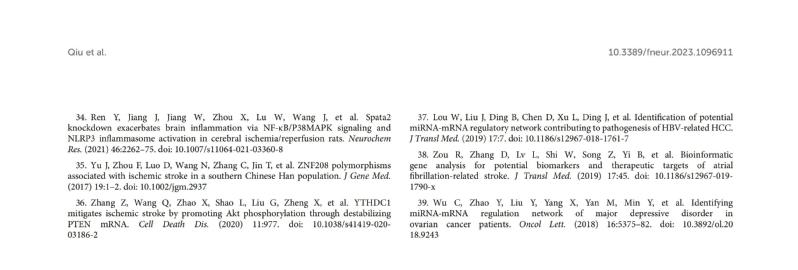本文著录格式:Qiu H, Shen L, Shen Y and Mao Y. Identification of a miRNA–mRNA regulatory network for post-stroke depression: a machine-learning approach. Frontiers in neurology, 2023, 14:1096911.
摘要:Objective: The study aimed to explore the miRNA and mRNA biomarkers in post-stroke depression (PSD) and to develop a miRNA–mRNA regulatory network to reveal its potential pathogenesis. Methods: The transcriptomic expression profile was obtained from the GEO database using the accession numbers GSE117064 (miRNAs, stroke vs. control) and GSE76826 [mRNAs, late-onset major depressive disorder (MDD) vs. control]. Differentially expressed miRNAs (DE-miRNAs) were identified in blood samples collected from stroke patients vs. control using the Linear Models for Microarray Data (LIMMA) package, while the weighted correlation network analysis (WGCNA) revealed co-expressed gene modules correlated with the subject group. The intersection between DE-miRNAs and miRNAs identified by WGCNA was defined as stroke-related miRNAs, whose target mRNAs were stroke-related genes with the prediction based on three databases (miRDB, miRTarBase, and TargetScan). Using the GSE76826 dataset, the differentially expressed genes (DEGs) were identified. Overlapped DEGs between stroke-related genes and DEGs in late-onset MDD were retrieved, and these were potential mRNA biomarkers in PSD. With the overlapped DEGs, three machine-learning methods were employed to identify gene signatures for PSD, which were established with the intersection of gene sets identified by each algorithm. Based on the gene signatures, the upstream miRNAs were predicted, and a miRNA–mRNA network was constructed. Results: Using the GSE117064 dataset, we retrieved a total of 667 DE-miRNAs, which included 420 upregulated and 247 downregulated ones. Meanwhile, WGCNA identified two modules (blue and brown) that were significantly correlated with the subject group. A total of 117 stroke-related miRNAs were identified with the intersection of DE-miRNAs and WGCNA-related ones. Based on the miRNA-mRNA databases, we identified a list of 2,387 stroke-related genes, among which 99 DEGs in MDD were also embedded. Based on the 99 overlapped DEGs, we identified three gene signatures (SPATA2, ZNF208, and YTHDC1) using three machine-learning classifiers. Predictions of the three mRNAs highlight four miRNAs as follows: miR-6883-5p, miR-6873-3p, miR-4776-3p, and miR-6738-3p. Subsequently, a miRNA–mRNA network was developed. Conclusion: The study highlighted gene signatures for PSD with three genes (SPATA2, ZNF208, and YTHDC1) and four upstream miRNAs (miR-6883-5p, miR-6873-3p, miR-4776-3p, and miR-6738-3p). These biomarkers could further our understanding of the pathogenesis of PSD.
关键词:post-stroke depression, gene signatures, miRNA–mRNA network, machine-learning, diagnostics-clinical characteristic



期刊介绍:
Frontiers in neurology是一本涉及神经科学所有领域的多学科开放获取期刊。期刊被SCIE收录,最新影响因子3.4,WOS分区为二区。期刊欢迎探讨神经系统疾病的诊断、性质、起因、治疗和公关卫生等方面的投稿。
Frontiers in neurology期刊专业版块主要的投稿文章类型:简要研究报告、病例报告、临床试验、数据报告、观点、政策与实例、综述、观点、原创性研究、政策与实践综述、研究方案、技术与代码等。
期刊致力于通过向研究人员、学者、临床医生和全球公众传播科学知识,推动神经病学领域的发展,以实现未来的科学突破。
投稿方式(网址):https://www.frontiersin.org/journals/neurology
作者简介:
南京医科大学,康复医学和理疗学博士,现为康复科学学院讲师。江苏省优秀博士毕业生,SCI 杂志外科学前沿客座编委,多本国际期刊审稿人。累计发表 10 余篇英文论文,H 指数为10。

(供稿/倪盈盈 审核/张伟锋)
